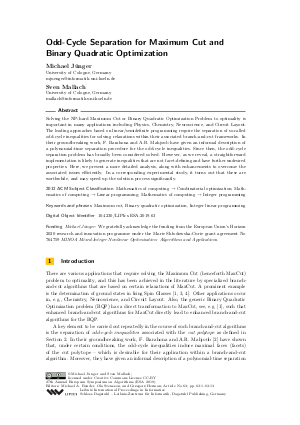Odd-Cycle Separation for Maximum Cut and Binary Quadratic Optimization
Authors Michael Jünger, Sven Mallach
-
Part of:
Volume:
27th Annual European Symposium on Algorithms (ESA 2019)
Part of: Series: Leibniz International Proceedings in Informatics (LIPIcs)
Part of: Conference: European Symposium on Algorithms (ESA) - License:
 Creative Commons Attribution 3.0 Unported license
Creative Commons Attribution 3.0 Unported license
- Publication Date: 2019-09-06
File

PDF
LIPIcs.ESA.2019.63.pdf
- Filesize: 0.75 MB
- 13 pages
Document Identifiers
Subject Classification
ACM Subject Classification
- Mathematics of computing → Combinatorial optimization
- Mathematics of computing → Linear programming
- Mathematics of computing → Integer programming
Keywords
- Maximum cut
- Binary quadratic optimization
- Integer linear programming
Metrics
- Access Statistics
-
Total Accesses (updated on a weekly basis)
0PDF Downloads0Metadata Views
Abstract
Solving the NP-hard Maximum Cut or Binary Quadratic Optimization Problem to optimality is important in many applications including Physics, Chemistry, Neuroscience, and Circuit Layout. The leading approaches based on linear/semidefinite programming require the separation of so-called odd-cycle inequalities for solving relaxations within their associated branch-and-cut frameworks. In their groundbreaking work, F. Barahona and A.R. Mahjoub have given an informal description of a polynomial-time separation procedure for the odd-cycle inequalities. Since then, the odd-cycle separation problem has broadly been considered solved. However, as we reveal, a straightforward implementation is likely to generate inequalities that are not facet-defining and have further undesired properties. Here, we present a more detailed analysis, along with enhancements to overcome the associated issues efficiently. In a corresponding experimental study, it turns out that these are worthwhile, and may speed up the solution process significantly.
Cite As Get BibTex
Michael Jünger and Sven Mallach. Odd-Cycle Separation for Maximum Cut and Binary Quadratic Optimization. In 27th Annual European Symposium on Algorithms (ESA 2019). Leibniz International Proceedings in Informatics (LIPIcs), Volume 144, pp. 63:1-63:13, Schloss Dagstuhl – Leibniz-Zentrum für Informatik (2019)
https://doi.org/10.4230/LIPIcs.ESA.2019.63
BibTex
@InProceedings{junger_et_al:LIPIcs.ESA.2019.63,
author = {J\"{u}nger, Michael and Mallach, Sven},
title = {{Odd-Cycle Separation for Maximum Cut and Binary Quadratic Optimization}},
booktitle = {27th Annual European Symposium on Algorithms (ESA 2019)},
pages = {63:1--63:13},
series = {Leibniz International Proceedings in Informatics (LIPIcs)},
ISBN = {978-3-95977-124-5},
ISSN = {1868-8969},
year = {2019},
volume = {144},
editor = {Bender, Michael A. and Svensson, Ola and Herman, Grzegorz},
publisher = {Schloss Dagstuhl -- Leibniz-Zentrum f{\"u}r Informatik},
address = {Dagstuhl, Germany},
URL = {https://drops.dagstuhl.de/entities/document/10.4230/LIPIcs.ESA.2019.63},
URN = {urn:nbn:de:0030-drops-111840},
doi = {10.4230/LIPIcs.ESA.2019.63},
annote = {Keywords: Maximum cut, Binary quadratic optimization, Integer linear programming}
}
Author Details
Funding
- Jünger, Michael: We gratefully acknowledge the funding from the European Union’s Horizon 2020 research and innovation programme under the Marie Skłodowska-Curie grant agreement No 764759 MINOA Mixed-Integer Nonlinear Optimisation: Algorithms and Applications.
References
- Francisco Barahona, Michael Jünger, and Gerhard Reinelt. Experiments in quadratic 0-1 programming. Mathematical Programming, 44(1):127-137, May 1989. URL: https://doi.org/10.1007/BF01587084.
- Francisco Barahona and Ali Ridha Mahjoub. On the cut polytope. Mathematical Programming, 36(2):157-173, June 1986. URL: https://doi.org/10.1007/BF02592023.
-
Caterina De Simone, Martin Diehl, Michael Jünger, Petra Mutzel, Gerhard Reinelt, and Giovanni Rinaldi. Exact ground states of Ising spin glasses: New experimental results with a branch-and-cut algorithm. Journal of Statistical Physics, 80(1-2):487-496, 1995.

- Caterina De Simone, Martin Diehl, Michael Jünger, Petra Mutzel, Gerhard Reinelt, and Giovanni Rinaldi. Exact ground states of two-dimensional ±J Ising spin glasses. Journal of Statistical Physics, 84(5):1363-1371, September 1996. URL: https://doi.org/10.1007/BF02174135.
-
Franz Rendl, Giovanni Rinaldi, and Angelika Wiegele. A Branch and Bound Algorithm for Max-Cut Based on Combining Semidefinite and Polyhedral Relaxations. In Matteo Fischetti and David P. Williamson, editors, Integer Programming and Combinatorial Optimization, pages 295-309, Berlin, Heidelberg, 2007. Springer.

